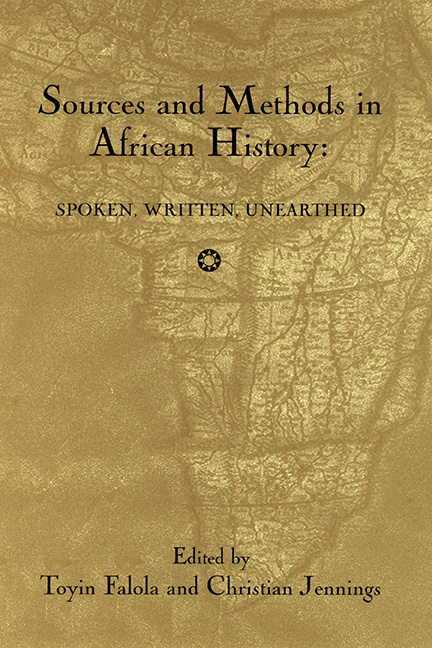Book contents
- Frontmatter
- Dedication
- Contents
- Acknowledgments
- Introduction
- Part I Archaeological Sources
- 1 Section Introduction: Archaeology and History
- 2 Trouble with Siblings: Archaeological and Historical Interpretation of the West African Past
- 3 Material Culture and Cadastral Data: Documenting the Cedarberg Frontier, South Africa, 1725–1740
- 4 Chronology, Material Culture, and Pathways to the Cultural History of Yoruba-Edo Region, 500 B.C.–A.D. 1800
- 5 For Trinkets Such As Beads: A Revalorization of Khoisan Labor in Colonial Southern Africa
- Part II Africa and the Atlantic World
- Part III Documentary Sources
- Part IV Oral Tradition
- Part V Innovative Sources and Methods
- Contributors
- Index
3 - Material Culture and Cadastral Data: Documenting the Cedarberg Frontier, South Africa, 1725–1740
from Part I - Archaeological Sources
Published online by Cambridge University Press: 25 October 2017
- Frontmatter
- Dedication
- Contents
- Acknowledgments
- Introduction
- Part I Archaeological Sources
- 1 Section Introduction: Archaeology and History
- 2 Trouble with Siblings: Archaeological and Historical Interpretation of the West African Past
- 3 Material Culture and Cadastral Data: Documenting the Cedarberg Frontier, South Africa, 1725–1740
- 4 Chronology, Material Culture, and Pathways to the Cultural History of Yoruba-Edo Region, 500 B.C.–A.D. 1800
- 5 For Trinkets Such As Beads: A Revalorization of Khoisan Labor in Colonial Southern Africa
- Part II Africa and the Atlantic World
- Part III Documentary Sources
- Part IV Oral Tradition
- Part V Innovative Sources and Methods
- Contributors
- Index
Summary
If rocks could talk, in the Western Cape they would tell tales of violence, theft, and retribution. But not all the rocks of the region necessarily need be mute witnesses to the complex and contested process of colonization. Although technically voiceless, Paleolithic chips and stone canvases convey information—which is not news to archaeologists. This information, however, too rarely is considered by historians. More importantly, it is rarely used in any systematic way to challenge, corroborate, or interrogate history as reconstructed from documentary sources. This paper is a methodological exploration of the ways in which historians can use prehistoric archaeological data to understand events and processes in the historic era better. Integrating different kinds of data creates a direct confrontation between notions of what is historic and what is prehistoric. The result of such a collision is an opportunity to construct a new epistemological pathway to Africa's past.
The paper uses as a case study the process of European settlement in the Olifants River valley, situated in the Cedarberg Mountains roughly 250 km north of Cape Town. At the time when the colonial frontier began advancing as far north as the Olifants River, the Dutch East India Company had maintained a refreshment station for its trading fleets at the Cape of Good Hope for three-quarters of a century. Since the first Company outpost was established at Table Bay, Dutch demand for land, fresh water, and meat—in the form and cattle and sheep—had put the Europeans at odds with the indigenous hunters and herders of the region, known collectively as Khoisan.
Previous historical studies of the relationship between Khoisan and colonists, as well as most treatments of colonial-era Khoisan, have relied exclusively on archival sources. This study uses Late Stone Age archaeology to shed light on the European colonization of the Olifants River area in the Cedarberg. I argue that the archaeological record suggests a greater precolonial intensity of land use than is conveyed in the early Dutch East India Company records. Furthermore, specific sites in the landscape were more important to both Khoisan and colonists than others.
- Type
- Chapter
- Information
- Sources and Methods in African HistorySpoken Written Unearthed, pp. 16 - 32Publisher: Boydell & BrewerPrint publication year: 2003



